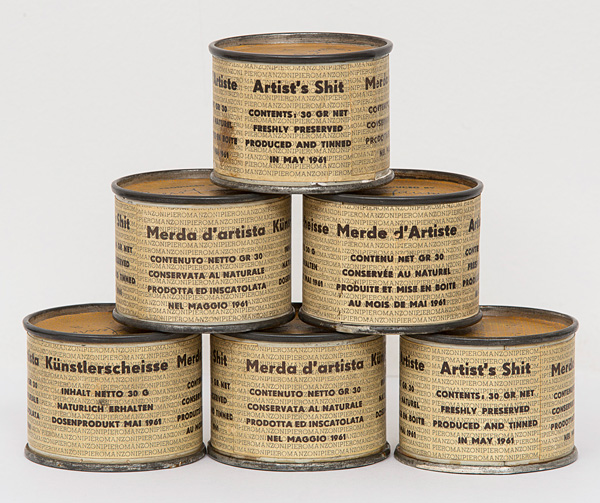
The Believer is pleased to present a series of excerpts from Jane Ursula Harris’ forthcoming book, After: The Role of the Copy in Modern and Contemporary Art. Harris’ survey assembles key examples of the copy from the onset of modernism to the present, and explores the copy’s relationship to the western canon.
When Egisto Manzoni told his son, “your work is shit”, he couldn’t have known the insult would inspire one of the most infamous works of Italian postwar art, Merda d’artista (Artist’s Shit), 1961. Consisting of 90 cans, each ostensibly filled with 30-grams of the artist’s own feces, “freshly preserved” and labeled as such, the artist’s response was particularly ironic given the fact that his father, an Italian count, ran a meat canning factory at the time.
If the work was a gesture worthy of Duchamp, like much of Manzoni’s work, it was also an act rooted in the alchemical. For in addition to literalizing his father’s taunt, Manzoni priced each can according to the market value of gold—around $1 a gram in 1961—effectively turning his shit into gold.
Merda d’artista shares similarities with an earlier series of Manzoni’s, Linee,1959, in which he drew lines on long scrolls of paper, ranging from 4 to 33 meters long, and rolled the paper into cardboard tubes. Each tube was given a price based on its length, and initially was intended to be opened and read by their owners like a book. Manzoni soon changed his mind, and decided the scrolls should remain hidden, shifting the work’s emphasis from a revelation of its contents to a speculation thereof.
“Although the Lines are hidden from view,” Manzoni writes, “their labels identify them as events that occurred at a particular time; they are like pieces of evidence bearing witness to the artist’s activity. The object of our gaze is therefore not a finished product, but rather the remnant of an act that has transpired.”
Manzoni’s play with fee structures, and his emphasis on the performative and conceptual, were reactions to the postwar consumerism of the 1950s, and the growing commodification of art. The economic boom that radically transformed Italy’s agrarian past into a cosmopolitan future particularly impacted Manzoni, whose family expected him to pursue law, and embrace his birth right as a member of the Italian ruling class. While Manzoni at first complied, he soon dropped out of law school to study philosophy, and then, with no formal training, began to make art.
 Piero-Manzoni, Achrome , 1958-59
Piero-Manzoni, Achrome , 1958-59
His postwar work was also a reaction to the hegemony of Abstract Expressionism. The latter’s Jungian explorations of the collective unconscious, and its existentialist leanings had equated subjective, spontaneous mark-making with authentic self-expression. Against this tide, Manzoni and like-minded peers—Yves Klein, Robert Rauschenberg, and Otto Piene, among them—questioned artistic agency by undermining notions of authorship and personal style, particularly in relationship to painting.
Manzoni’s Achromes, 1958, for example, of which there were over 300, defined and constructed themselves. Like Rauschenberg’s White Paintings (1951), and Yves Klein’s blue monochromes (1947-61), they used seriality and monochromy to produce effects beyond the artist’s control, creating abstract compositions independent of brush and line.
Manzoni’s Achromes utilized kaolin, a soft clay employed in the making of porcelain, mixed with glue, which at first was simply poured over canvas, allowing random surface effects to occur as it dried. Later works incorporated folds, grooves, and stitched squares, which were subjected to the same kaolin-glue treatment. The introduction of “alternative” materials followed, including cotton, fiberglass, bread rolls, polystyrene, and cobalt chloride (a chemical that created varying phosphorescent effects over time). The self-generating nature of these alchemical compositions derived from a confluence of their material properties, the role of chance, and Manzoni’s use of repetition to symbolize infinity.
Merging a conceptual impulse with Eugène Delacroix’s notion of the “indefinable” or sublime in art, Manzoni’s Achromes avoided allusive and allegorical content, and “liberated the canvas from its private and social burdens, emphasizing the surface and materials as the true loci of the work.” Their ability to do so undercut Abstract Expressionist conflations of mark-making with the personal and revelatory, and along with his father’s insult, became the basis for Manzoni’s Merde d’Artista. As he infamously proclaimed, “If collectors want something intimate, really personal to the artist, there’s the artist’s own shit. That is really his.” The veracity of Manzoni’s claim, of course, required a degree of faith on the part of collectors and audience alike, since verifying the contents of a can essentially required destroying the work.

Nari Ward, Canned Smiles , 2013 , image courtesy of Lehmann Maupin
It is exactly that element of faith (of what was inside), and the way it entangled notions of value and authenticity that appealed to Nari Ward, whose Canned Smiles, 2013, were made after Manzoni’s iconic work. Variously labeled “Jamaican” and “Black”, Canned Smiles found similar impetus in a narrow-minded critique—in Ward’s case, a collector who told the Jamaican-born artist his work didn’t seem Jamaican enough because it wasn’t happy or bright,. Ward’s response to the racist stereotype implicit in that critique was a sardonic, if equally poetic, gesture.
“The collector’s words haunted me, triggered me to collect smiles. Piero Manzoni questioned ideas of value with his shit cans, so, alluding to his irreverence, I made a series of cans with mirrors in them, Canned Smiles, 2013; I captured people’s smiles and closed the cans. They were labeled ‘Black Smiles’ and ‘Jamaican Smiles’…. In theory, the smile is there, but the smile isn’t there if you open it… You have to believe for it to really resonate.”
Ward’s version removes even the possibility of proof as the smiles he collected—his own, and his children’s—are intangible forms of bodily expression, if no less intimate than Manzoni’s excrement.
Like Merde d’Artista, Canned Smiles has roots in earlier bodies of work, namely Happy Smilers: Duty Free Shopping, 1996, Mango Tourist, 2011, and Sunsplashed, 2013. All of these works explore the stereotype of the happy Jamaican through the complex lens of bicultural identity as the Jamaican-born artist emigrated with his family to the United States at the age of 12. While these works are suffused with nostalgia for his island home, the persistent expectation that he perform a cultural identity consistent with cultural stereotypes (ala the collector’s comment) consistently underscores their explorations of race, memory, immigration, and belonging.
 Nari Ward, Happy Smilers , 1996, Jeffrey Deitch Gallery
Nari Ward, Happy Smilers , 1996, Jeffrey Deitch Gallery
Happy Smilers: Duty Free Shopping, 1996, was a storefront-styled installation that Ward named after a Jamaican band that the artist’s uncles performed in for tourists in the 1970s. For the piece, Ward piped upbeat Jamaican folk-style music that his uncles’ eponymous band played into the store’s entrance, and created a facade of pleasure that the back gallery quickly confounded.
In the back, one encountered a series of large-scale sculptures comprised of discarded household objects woven together with defunct fire hoses. Like a warehouse of lost dreams, their hulking cargo-like forms lined the walls—the commerce they once represented, with its promise of a better life, rendered as mute and useless as the white sand covering the floor. A soundtrack of rain on tin roofs—one of the artist’s earliest childhood memories—filled this rear room, adding to the overall sense of physical and emotional dislocation. Ward’s experience of living above a Caribbean candy store in Harlem that served as a front for illegal gambling was yet another element that fed Happy Smilers’ overall spatial and mnemonic discord.
The 10-foot-tall snowmen of Mango Tourists, 2011, offer a similar sense of unease. Created for Mass MoCA, a contemporary art museum located in an area where the rise of an art-driven tourist economy has replaced manufacturing jobs, the snowmen are embedded with mango seeds, and woven from burned foam and discarded electrical parts gathered from defunct nearby factories. Like Happy Smilers, Mango Tourists also conjure the disparate geographies of Ward’s native Jamaica and his adopted home.
Ward’s use of the “happy Jamaican” stereotype is perhaps most obvious in Sunsplashed, 2013, a series of large-scale photographs in which the artist stands stiffly in various homes, dressed in a fuscia-colored shirt, white pants, and a straw hat. Amid potted plants, animal skins, primitive masks and other signifiers of exotica, his expressionless face pointedly denies, and simultaneously highlights, tropes about the jovial islander.
 Nari Ward, Sun Splashed , 2013, image courtesy Lehmann Maupin
Nari Ward, Sun Splashed , 2013, image courtesy Lehmann Maupin
Ward is well aware of the stereotype’s roots in minstrelsy, a racist form of Antebellum theater popularized in the 1830s to defend and justify slavery. These satiric, often slapstick performances featured whites in blackface performing a host of stock slave characters—Sambo, Mammy, Pickaninny, Uncle Tom—who ignorant and carefree, knew their place, and sought no other. Those who dared to counter such docile stereotypes were viciously lampooned as well. The pompous “Zip Coon”, for instance, who dared to educate himself, and symbolized free blacks, was caricatured as an urban black dandy; “a larned skoler” who paraded about in frilly clothes and spoke in a string of malapropisms. As sociologist David Pilgrim noted, “His use of bastardized English delighted white audiences and reaffirmed the then commonly held beliefs that blacks were inherently less intelligent.”
The blackface dandy arose to redress the threat of real black dandies who, symbolizing the growing power, pride, and enterprise of free blacks, bravely challenged racial and social norms. Harnessing this subversive potential, as Benjamin Miller has suggested, “black performers and activists such as George Walker and W.E.B. Du Bois inhabited and transformed the blackface dandy stereotype” to create the “possibility of overcoming, in a productive and unifying way, the white animosity toward black freedoms.” An 1897 review in the African American newspaper, the Indianapolis Freeman, lauding Walker’s “incandescent comportment” conveys the significance of such portrayals for black spectators as well.
When Walker and his fellow Vaudevillean Bert Williams, began to incorporate the cakewalk—a dance white audiences loved, unaware that it originated with plantation slaves imitating their master’s walk—into their blackface acts, the duo distinguished themselves with the name, ”The Two Real Coons.” Walker allegedly explained their name choice as a necessary tool to gain the notice of white theater owners, thereby functioning paradoxically as a form of resistance and accommodation. The appropriation of such a racist epithet anticipated what is now known as “linguistic reclamation”, which Robin Brontsema defines as a process whereby “Laying claim to the forbidden, the word as weapon is taken up and taken back by those it seeks to shackle”.
 Nari Ward, Sugar Hill Smiles , 2014, image courtesy Lehmann Maupin
Nari Ward, Sugar Hill Smiles , 2014, image courtesy Lehmann Maupin
References to the ever-smiling, ever-deferential Sambo in Ward’s work function similarly, effecting a kind of critical negation as the artist either refuses to smile or re-inscribes that caricature grin with agency. Given the persistence of the “happy Jamaican” in tourist propaganda, the lived reality of those who must perform it daily are a constant source of inspiration, and as he makes clear: “they’re not victims, they’re survivors. The smile was resilience, the smile was fortifying yourself, and going out there and making money for your family.”
In Sugar Hill Smiles, 2014, an extended version of Canned Smiles, Ward set up a portable canning machine on the streets of Harlem’s northern neighborhood, Sugar Hill. He invited 2,000 individual residents to smile into their mirror-bottomed interiors, then sealed, labeled, and sold them for $10 a can.
Sugar Hill, from the Jazz Age to the 1950s, was synonymous with Harlem’s black elite—home to the likes of Ralph Ellison, Joe Louis, W. E. B. Du Bois, Lena Horne, James Baldwin, and Zora Neale Hurston, among other luminaries. For decades after, it suffered from municipal disinvestment and decay until the real estate boon led to its designation as a historic district in 2000. Today its illustrious past and architectural beauty are packaged and sold to AirBnB clients at $400/night, and the value of once affordable houses has increased by over one hundred and fifty percent.
Like Canned Smiles, the latent reference to blackface in this secondary work is both ironic and sincere; a commentary on how [urban] blackness is often maligned and then commodified. Black artists since the 1960s have invoked the complex, ongoing legacy of “blacking up” as a means to intervene in its perpetuation, particularly in relation to the thorny issue of cultural appropriation. Many of Ward’s peers—William Pope.L, Mark Steven Greenfield, and Hank Willis Thomas, among them—have created provocative, nuanced works that defy and limn its impact, accordingly. The ephemeral, playful nature of Ward’s Smiles, however, remains just as indebted to Manzoni’s influence, recalling in particular the latter’s emphasis on “the remnant of an act that has transpired” rather than a “finished product”.
While Manzoni’s work was largely a reaction to the commodification of art, and Ward’s to that of black culture, both resist and expand delimiting categories of identity—artistic and cultural, respectively—by employing alternative forms of authorship. Ward’s Canned Smiles, and Sugar Hill Smiles turned self-expression into a “canned” act through the performative contributions of family and community members. The intimate act of smiling is thus rendered a collective form of resistance; an antidote to imposed stereotypes that define authenticity in racist terms. Manzoni’s send-up of Abstract Expressionism’s preoccupation with subjectivity attempted much the same—albeit aesthetically—by relinquishing control to nonhuman forces.
Manzoni’s Merda d’artista, and Ward’s Canned Smiles, made 52 years later, were nonetheless conceived under entirely different social conditions. Manzoni was a wealthy white Italian who worked in Europe’s booming postwar period, his promising career coming to an abrupt end with his untimely death at age 29. Ward, a Jamaican immigrant to the United States, by contrast, came of age in the gritty streets of late 1970s New York, and continues to develop his mature, complex practice, now three decades old.
That practice, and its central concern with the allusive and alchemical potential of found objects, certainly partakes in Manzoni’s youthful, exuberant claim that “the whole world is available as material”, but it is more consequently shaped by experiences of racism, classism, xenophobia, and biculturalism. Ward’s dedication to an embodied relationship to artistic process and labor—‘I can’t just do it on a computer, or have it made by a fabricator”—and his ongoing exploration of the confounding nexus of memory, nostalgia and place, also find their impetus in such experiences.
In the end, however surreal or abstract the results, Ward’s conceptual repurposing of everyday objects is rooted in the political and the corporeal. Rather than reject the narrative potential of materials as Manzoni did, he embeds them with a plurality of meaning, combining the familiar and the strange in disjunctive associations that encourage viewers to question their assumptions about art, and the world they live in.
Purchase a copy of the current issue of The Believer here, and subscribe today to receive the next six issues for $48.




